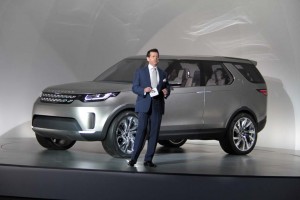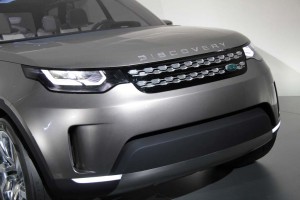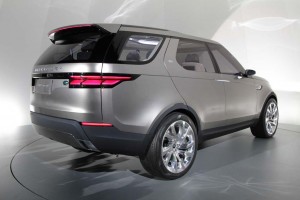
Land Rover Design chief Gerry McGovern with the Discovery Concept, which will be the maker's next workhorse SUV and named Discovery Sport.
Land Rover’s upcoming workhorse SUV has gotten a new name, the first production spin-off of the Land Rover Discovery Vision Concept unveiled at the New York Auto Show this week to be dubbed the Land Rover Discovery Sport when it launches next year.
But it will be just one of at least two, and possibly three production models to come out of the program that the Vision Concept hinted at, with more to follow in the years beyond the Sport model’s launch.
“I am proud to confirm the nameplate that will make Discovery a family of vehicles for the first time,” said Gerry McGovern, Land Rover Design Director.” It will be called Discovery Sport and will go on sale in 2015. This will be a versatile and capable SUV and is the first expression of the Discovery Vision Concept unveiled here in New York.”

The next Land Rover will be called the Discovery Sport. Other derivatives are sure to follow in the years ahead.
The Land Rover Discovery Vision Concept will be on display at the 2014 NY Auto Show for the next week. But it made an out-of-this-world debut during an earlier preview appearing alongside a mock-up of the Virgin Galactic Enterprise, the world’s first commercial manned spacecraft, aboard the retired aircraft carrier, the USS Intrepid.
The Discovery – sold in the U.S. as the Land Rover LR4 – has long been one of the British maker’s most popular models and the Vision Concept hints at what’s to come when an all-new version debuts next year. Or, more precisely, what’s to come when a whole new “family” of Discovery models begins to roll out in 2015, LR officials revealed.
“This concept represents our vision of a family of Discovery (models), not just one,” said McGovern.
The strategy mirrors what the British firm has done with its top-line Range Rover nameplate. Along with the flagship model there’s now a smaller Range Rover Sport as well as a compact version, the Range Rover Evoque. The proliferation strategy is in line with what competing luxury brands have been doing as they race to fill every conceivable niche in the bid for maximum sales.
In Land Rover’s case, the maker plans to target three distinct market segments – or “pillars” — going forward. The next Discovery will anchor the “leisure” group, while the Defender will serve as the heart of the “dual purpose” group. The Range Rover and its spin-offs will, no surprise, make up the “luxury group.”
It’s become a trend in the auto industry to reveal concept cars and trucks that are really just thinly disguised versions of production vehicles. But McGovern stressed that the Discovery Vision Concept making its public debut this week at the New York Auto Show is only mean to give a hint of the Disco/LR4’s future design direction.

Based off the Vision Concept, the new Discovery Sport is expected to hit dealer showrooms next year.
“What this explores is the level of differentiation from Range Rover and Discovery,” McGovern told TheDetroitBureau.com.
The show car adopts a more modern and aerodynamic design, the design chief insisting one of his goals was to prove that “capable” can be “sexy,” as well. While still clearly meant to be able to take on some serious trails – or snow-covered streets – the new concept adopts a more upscale appearance. There’s plenty of glass to make it easier for driver and passengers to watch the world go by, with raised “stadium seating” for those in back.
(Muscle cars muscle their way back into the Big Apple. For more, Click Here.)
The Discovery Vision Concept adopts pillar-less “suicide,” or reverse-opening rear doors, but McGovern said that was intended solely for the show car to make it easier to see the decidedly more premium interior.
The Vision Concept also is being used to show off a range of new technologies that Land Rover is exploring, some of which will show up in the production Discovery next year. There are no visible door handles. Instead, a driver would open the vehicle up with a remote fob or the appropriate gesture.
(Click Here to get details on the new Dodge Challenger and Charger.)
In fact, gesture controls are used to operate a number of different functions inside the vehicle, including its lights and infotainment system. And, like many of its competitors, Land Rover has slashed the number of knobs and buttons, migrating controls to the Vision Concept’s touchscreen display.
“We want (Discovery) to be far more intuitive” to operate, McGovern explained.
(To see more about the judge declining to order GM to park recalled cars, Click Here.)
Another feature making its debut has been dubbed the “Transparent Hood,” or “Bonnet” to the Brits. The system uses cameras mounted in the grille to capture a rolling image of terrain and obstacles that would normally be out of sight for the Discovery’s driver. The images are then projected on a full-width heads-up display at the bottom of the windshield, making it look as if the driver has x-ray vision and can see through the Vision Concept’s hood.
Land Rover is currently exploring the possibilities for the Transparent Hood technology and isn’t saying whether it will eventually come to market.
